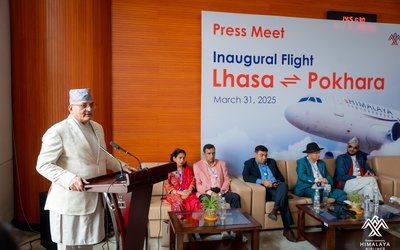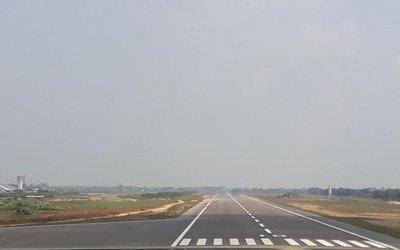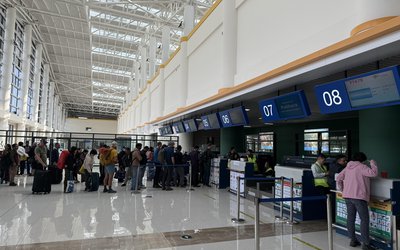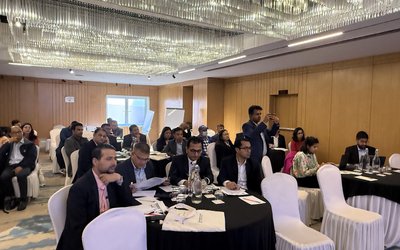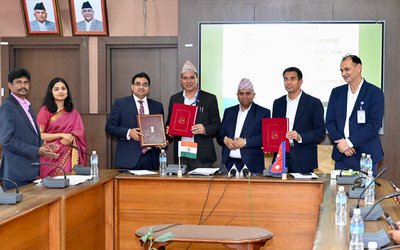
Flying almost twenty-five years with two aging Boeing 757 planes, Nepal Airline will enter the international aviation market by the middle of April 2015 with an Airbus A320. This will begin a new era in Nepal’s aviation history when the country’s only international flag carrier will join the global airlines having the aircraft with latest and sophisticated technology.
Just a decade ago, Nepal Airlines carried almost half of the tourists visiting Nepal. However, the number has drastically declined due to its failure to add new aircraft in its fleets over the years.
Nepal’s national flag carrier, Nepal Airlines Corporation (NAC) has signed a firm order for two Airbus A320 aircraft equipped with Sharklet fuel saving wing tip devices, following a Memorandum of Understanding (MoU) agreed in April 2013.
“As the assembling of the aircraft is close to completing, one of the aircraft ordered by Nepal Airlines will be delivered in schedule,” said Sheel Shukla, senior sales Director, in a conversation with a selected media group.
The A320 was chosen for its unique performance capability required for high altitude airport operations and its flexibility that enables it to be deployed on a wide variety of routes. Equipped with Sharklets to deliver unbeatable economics and up to four percent reduction in fuel burn, the aircraft will be the cornerstone of NAC’s modernized fleet.
“Nepal is a landlocked nation, and aviation is our window to the world. It welcomes explorers, trekkers and pleasure seekers, cultural and ecological visitors and its importance cannot be overstated for our country. Our new A320s with Sharklets will help us to increase capacity, capitalize on the growth in tourism,” said Madan Kharel, Managing Director, Nepal Airlines Corporation.
Airbus argued that its agile and high performance A320 Family aircraft are a lifeline and economic driver for prosperity for a country like Nepal. “Our Sharklets deliver up to four per cent savings in fuel burn, which is a great advantage for any carrier. “We are delighted to welcome Nepal Airlines as our newest customer.”
“The new A320s are fully equipped with latest Required Navigation Performance (RNP) technologies, allowing the aircraft to fly precisely along predefined routes using state-of-the-art onboard navigation systems. This is particularly beneficial for operations at high altitude airports which are constrained by mountains such as the carrier’s main base in Kathmandu.
This is not the first time Nepal is flying airbus. Nepal Airlines had already introduced Airbus in its fleet a decade ago for two years with a lease agreement with a private company.
After associating almost five decades with Boeing and American Airplanes, starting from DC3 to B757, Nepal Airlines is finally moving to two European built new Airbuses. This is a great departure in the history of Nepalese aviation.
Douglas DC-3 Dakota
The 28-seater Dakota, NAC's very first aircraft, has become an icon of Nepal‘s aviation history. In many parts of the Kingdom, the people's initial encounter with the modern world was the DC-3. The last of these planes flew into the sunset in 1973.
The Fokker Friendship F027 launched Nepal into the turboprop era. In operation from 1966 to 1970, it carried 44 passengers and flew to NAC's international destinations. A lot of prestige was attached to travelling in a Fokker in those days.
Hawker Siddley HS-748 Avro
Nepal Airlines obtained its first Avro in 1970. The 44-seater planes were utilized on domestic and international sectors.
Boeing 727
The nation became the proud possessor of a jet plane carrier with the induction of a Boeing 727 in 1972 and remained in service till 1993. The first of Nepal Airlines two B757s arrived in 1987. Flying on long-haul routes and displaying the national flag at world airports, they helped Nepal make its presence felt in the international aviation scene.
“The A320neo (new engine option) is the latest of many product upgrades as Airbus continues to invest around 300 million euro a year in the A320 Family to maintain its position as the most advanced and fuel-efficient single-aisle aircraft family,” said Justin Dubon, media relations and head of Global News of Airbus.
With a capacity of 180 seats, A320 is fuel efficient and it will save the flying cost, making Nepal Airlines competitive among other international airlines currently flying to Nepal.
As fewer than five months remain to deliver the first aircraft in Nepal, Boeing has already started to train Nepalese technical staffs. “Some Nepal Airlines engineers are in the Indian city of Bangalore for training and the training of pilot will begin in the coming days,” said Dubon.
As a new customer in the region, the Airbus team has been giving all possible services to Nepal Airlines. “We provide all the necessary services to our customer, Nepal Airlines,” said Llari Haakana, Airline Marketing Manager, and Marketing Division, Airbus.
After flying with two Boeing 757, Nepal Airline has already lost its own credibility shrinking the market share as well as flight destinations just to four. With the arrival of Airbus A320, Nepal Airlines will change its image and market share.
With the time of delivery of new aircraft coming closer, Airbus has activated all its work to satisfy its Nepal Airlines by sending frequent high level teams. This closeness of Airbus has owned the heart and mind of Nepalese.
Airbus has shown that along with delivering technically superb aircraft, it is also very much concerned about the needs and necessities of Nepal Airlines.

Keshab Poudel
Poudel is the editor of New Spotlight Magazine.
- FM Dr. Deuba’s India Visit: Mission Aborted
- Mar 26, 2025
- AMBASSADOR MAEDA TORU: Warm Regards
- Mar 24, 2025
- PRO-MONARCHY MOVEMENT: Rising Dissatisfaction
- Mar 23, 2025
- Dr. PRABIN MANANDHAR: Person With Humility
- Mar 16, 2025
- US SUSPESION OF GRANT: Impact On Nepal
- Mar 10, 2025
